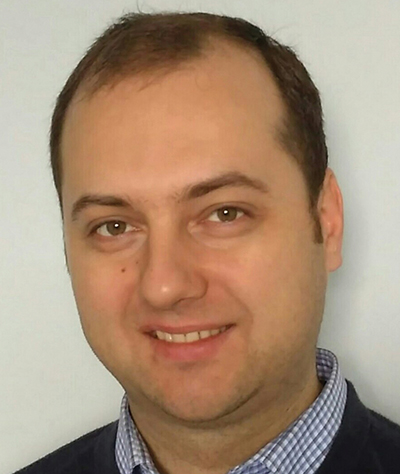Biochemist chases the role of retinoids in fat burning
 Igor Shmarakov and his mentor published four papers together when their labs were half a world apart.When Igor Shmarakov first learned about retinoids, he had no idea his research interest would send him on a journey back and forth across the globe.
Igor Shmarakov and his mentor published four papers together when their labs were half a world apart.When Igor Shmarakov first learned about retinoids, he had no idea his research interest would send him on a journey back and forth across the globe.
Shmarakov was born and raised in Ukraine. While working on his Ph.D. in biochemistry at Chernivtsi National University, he studied the role of retinoids, natural and synthetic derivatives of retinol, or vitamin A, in inhibiting tumor growth in rat models. After earning his degree, he was appointed an associate professor in the university’s department of biochemistry and biotechnology.
In 2008, Shmarakov received a one-year Fulbright scholarship to do a collaborative research study and was matched with , a professor of nutritional medicine at the Columbia University College of Physicians and Surgeons, thus beginning a fruitful academic relationship.
Shmarakov returned to Ukraine when his fellowship ended, but he was determined to come back to the U.S. to pursue his dream of becoming an independent researcher. He had a lab at Chernivtsi and supervised graduate students, Shmarakov said, “but at the same time, I continued doing collaborative research studies with Dr. Blaner.”
The long-distance partnership was a challenge, but the two published four papers together between 2009 and 2016. In 2016, Shmarakov applied for an associate research scientist position at Columbia, where he now works under Blaner’s mentorship.
“(The) transition from the Ukrainian academic system into the American academic system was the biggest challenge for me,” Shmarakov said. “Dr. Blaner was very supportive. I owe him. … He kept me scientifically active, and that’s how I was able to come back to the U.S.”
The Journal of Lipid Research has invited Shmarakov to talk about his work in the field of metabolic disease at the 2019 ɬ� annual meeting.
Role of RBP4 in metabolic disorders
Nonalcoholic fatty liver disease is a metabolic disorder caused by accumulation of fat in the liver. Scientists originally thought the sole function of retinol binding protein 4, or RBP4, was to transport retinol to extrahepatic tissues in times of dietary insufficiency. It is now proposed that adipose-derived RBP4 contributes to the pathogenesis of type 2 diabetes, linking type 2 diabetes with obesity and other obesity-related metabolic diseases.
RBP4 is expressed in both white and brown adipose tissue. The latter, called BAT, contains a large number of mitochondrial uncoupling proteins, allowing them to dissipate thermal energy rather than synthesize ATP. Therefore, metabolically active BAT has therapeutic potential in metabolic disorders.
To study the role of adipocyte-derived RBP4 in metabolic disease, Igor Shmarakov uses several transgenic mouse models, including one that overexpresses human RBP4 in both white and brown adipocytes. When fed a high-fat diet, these adi-hRBP4 mice develop nonalcoholic fatty liver disease, obesity and insulin resistance more readily than matched wild-type mice. Shmarakov’s recent work explores the biochemical cause of this higher weight gain in the adi-hRBP4 mice. The further increase in RBP4 expression in the adi-hRBP4 mice involves a decrease in mitochondrial numbers. Shmarakov proposes that this accounts partially for the excessive weight gain in the adi-hRBP4 mice.
Enjoy reading ASBMB Today?
Become a member to receive the print edition four times a year and the digital edition monthly.
Learn moreGet the latest from ASBMB Today
Enter your email address, and we’ll send you a weekly email with recent articles, interviews and more.
Latest in People
People highlights or most popular articles

Sketching, scribbling and scicomm
Graduate student Ari Paiz describes how her love of science and art blend to make her an effective science communicator.

Embrace your neurodivergence and flourish in college
This guide offers practical advice on setting yourself up for success — learn how to leverage campus resources, work with professors and embrace your strengths.

Survival tools for a neurodivergent brain in academia
Working in academia is hard, and being neurodivergent makes it harder. Here are a few tools that may help, from a Ph.D. student with ADHD.

Quieting the static: Building inclusive STEM classrooms
Christin Monroe, an assistant professor of chemistry at Landmark College, offers practical tips to help educators make their classrooms more accessible to neurodivergent scientists.

Hidden strengths of an autistic scientist
Navigating the world of scientific research as an autistic scientist comes with unique challenges —microaggressions, communication hurdles and the constant pressure to conform to social norms, postbaccalaureate student Taylor Stolberg writes.

Richard Silverman to speak at ASBMB 2025
Richard Silverman and Melissa Moore are the featured speakers at the ASBMB annual meeting to be held April 12-15 in Chicago.

